Porgy and Bess Program [pdf] - American Repertory Theater
Porgy and Bess Program [pdf] - American Repertory Theater
Porgy and Bess Program [pdf] - American Repertory Theater
You also want an ePaper? Increase the reach of your titles
YUMPU automatically turns print PDFs into web optimized ePapers that Google loves.
egretted doing it. But Parks has talked about the<br />
script’s flirtations with minstrelsy <strong>and</strong> “noble savage”<br />
cliches as a “shortcoming of underst<strong>and</strong>ing.”<br />
While the creative team has altered material in<br />
the book, always with a careful h<strong>and</strong>, Paulus says<br />
the stereotyping usually stems from the lack of<br />
dramaturgical purpose.<br />
“‘I Got Plenty of Nuthin’’ can have a bad<br />
rap, because here it is, this African-<strong>American</strong><br />
man singing how he’s happy with nothing. What<br />
Suzan-Lori was interested in, even more than<br />
[the derogatory stereotyping], is the context of<br />
the song in the show. So she has written a few<br />
lines that give it a purpose that relates to the specific<br />
action of the story at that moment. We’re<br />
looking at anything in the script that sticks out as<br />
dramaturgically questionable, because usually the<br />
problem is that the characters are incomplete.<br />
Therefore, you can look at them as cliches.”<br />
Paulus may be striving to make <strong>Porgy</strong> <strong>and</strong> <strong>Bess</strong><br />
resonate today, but she certainly has a reverence<br />
for the work’s rich history. After all, she taught a<br />
course on <strong>Porgy</strong> at Harvard last spring with<br />
renowned cultural historian Marjorie Garber.<br />
Indeed, Paulus’ grasp of <strong>Porgy</strong>’s roots are impressive.<br />
She mentions how George Gershwin <strong>and</strong><br />
his associates famously walked Boston Common<br />
the night after the show’s premiere <strong>and</strong> decided<br />
to make major cuts to the show. She talks<br />
passionately about <strong>Porgy</strong>’s complex social <strong>and</strong><br />
racial history <strong>and</strong> its evolution over the decades<br />
in various mediums. She points out that <strong>Porgy</strong><br />
had its real breakthrough <strong>and</strong> solidified its status<br />
in the canon when it was revived on Broadway<br />
in 1942 as a musical under the auspices of<br />
Cheryl Crawford, ran for nine months, then<br />
toured the country.<br />
In the 1950s, it became a main diplomatic<br />
export of the U.S. State Department, she says,<br />
<strong>and</strong> the cast (including a young Maya Angelou)<br />
were some of the first <strong>American</strong> artists to perform<br />
behind the Iron Curtain. When the 1960s<br />
hit, with the rise of the Civil Rights <strong>and</strong> black<br />
power movements, few wanted to touch <strong>Porgy</strong><br />
<strong>and</strong> <strong>Bess</strong> because of its stereotypes <strong>and</strong> perceived<br />
racism. But at that time, the music exploded into<br />
the popular consciousness, as jazz <strong>and</strong> blues<br />
artists, from Ella Fitzgerald <strong>and</strong> Billie Holiday to<br />
Stop Guessing<br />
tutoring test preparation admissions<br />
call to inquire about courses <strong>and</strong> small group lessons<br />
617 395 4160 or visit us at veritutors.com<br />
$50 off your first lesson if you sign up before september 1 st . just mention this ad.<br />
10 AMERICAN REPERTORY THEATER


![Porgy and Bess Program [pdf] - American Repertory Theater](https://img.yumpu.com/24481101/10/500x640/porgy-and-bess-program-pdf-american-repertory-theater.jpg)
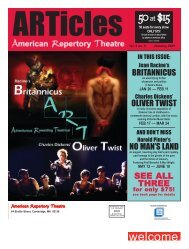
![Wild Swans Program [pdf] - American Repertory Theater](https://img.yumpu.com/49339866/1/167x260/wild-swans-program-pdf-american-repertory-theater.jpg?quality=85)
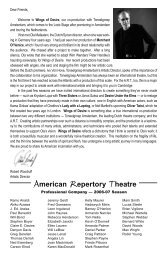
![Press Release: Trojan Barbie [pdf] - American Repertory Theater](https://img.yumpu.com/47571290/1/190x245/press-release-trojan-barbie-pdf-american-repertory-theater.jpg?quality=85)
![Articles issue as 4_2 [pdf] - American Repertory Theater](https://img.yumpu.com/45053160/1/190x249/articles-issue-as-4-2-pdf-american-repertory-theater.jpg?quality=85)
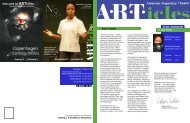
![Three Pianos Program [pdf] - American Repertory Theater](https://img.yumpu.com/41616353/1/167x260/three-pianos-program-pdf-american-repertory-theater.jpg?quality=85)
![Three Sisters [pdf] - American Repertory Theater](https://img.yumpu.com/40969361/1/190x245/three-sisters-pdf-american-repertory-theater.jpg?quality=85)

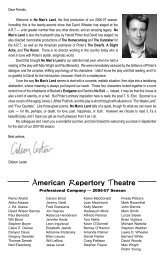
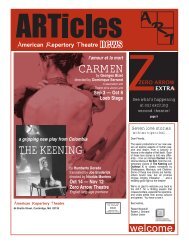
![Program: Sleep No More [pdf] - American Repertory Theater](https://img.yumpu.com/24629394/1/167x260/program-sleep-no-more-pdf-american-repertory-theater.jpg?quality=85)
![Program: Carmen [pdf] - American Repertory Theater](https://img.yumpu.com/24481072/1/190x245/program-carmen-pdf-american-repertory-theater.jpg?quality=85)
